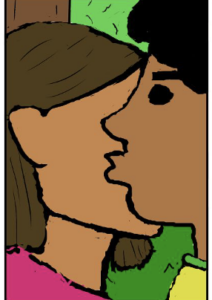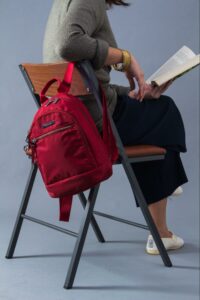1 ¡Soy yo!
Objectives
Communicative goals
- Greet, meet, and introduce individuals and say good-bye.
- Exchange basic personal information.
Cultural goals
- Learn appropriate behavior when meeting someone from a different culture.
- Understand how people from different Hispanic cultures greet one another and the courtesy expressions expected on a day-to-day basis.
- Begin to form cultural sensitivity that will transform into cultural competence.
I. Tira cómica
In this tira cómica, you will meet Ana and follow her as she greets and meets friends and acquaintances at home and on her university campus.



Actividad 1.1 Preguntas de comprensión
II. ¿Te fijaste que…? La cortesía en el mundo hispano
La cantidad de saludos y despedidas
Actividad 1.2. La cantidad de saludos y despedidas
3. What do you notice about the number of salutations (greetings) and goodbyes? Do they seem short or long in comparison to what you are used to?
Conexión cultural: La cantidad de saludos y despedidas

Proper greetings and good-byes are extremely important in the cultures of the Hispanic world. While it’s not necessary to greet every stranger on, say, a crowded city bus, in private and semiprivate spaces, it is a social norm to greet those you see, even if you are not closely acquainted. Notice how Ana takes the time to greet her neighbor as she leaves her house as well as to introduce herself to her classmate as she sits down. Particularly (but not exclusively) in Latin America, politeness and courtesy are highly valued, and the way you greet (or don’t) greet) someone will likely be an important step in getting your relationship off on the right foot! Greetings do not have to be complicated; many times a simple hola (hello) or buenos días (good morning) is enough. The objective is to acknowledge people around you or near you, as this is a sign of respect.
The same is true for closing a conversation or leaving a private or semiprivate space. It is just as important to say good-bye as it is to say hello to demonstrate respect and courtesy to the individuals in your environment. Following that same idea, Spanish speakers often layer good-byes, using multiple phrases to let their conversational partner know that they will be leaving. Sometimes the conversation continues on for several minutes after the initial good-bye!
Actividad 1.3. Los saludos y las despedidas: Comprehension check
Consider the following environments and decide whether you should greet / say good-bye to the individuals present or that you encounter in each one. Answer sí if you should and no if you should not.
¿Formal o informal? El uso de tú y usted
Actividad 1.4 El uso de tú y usted
Conexión cultural: El uso de tú y usted
Just like in English, Spanish has both formal and informal registers, or forms of address. In English, those differences are evident in the words one chooses to use to greet and address someone. Whereas you might nod and say “What’s up, man?” to your close friend, you would likely choose a more formal expression and form of address when speaking to your professor or the university president (perhaps “Good morning, Dr. Sánchez”). Spanish has those same differences, plus distinct personal pronouns and verb forms for a formal “you” (usted and ustedes) and an informal “you” (tú and vosotros).
The use of formal and informal registers varies according to national culture in the Hispanic world. Whereas the majority, if not all, of the countries use the formal register in a professional environment, there are slight variations in its use in informal social settings. Some countries like Mexico, Honduras, and Costa Rica use the formal register (usted) to address older family members as a sign of respect. In Spain the informal register (tú and vosotros) is commonly used with all family members and friends. Countries like El Salvador, Honduras, and Argentina use a different pronoun, vos, instead of tú to address someone informally. A good rule to follow is to address people older than you and people you do not know using a formal register and people your own age or younger with an informal register (tú and vosotros), with the exception of professional situations. If you are unsure, you can always just ask how the person prefers to be addressed.
It is important to consider different types of situations and determine the type of register that you would need to use.
Actividad 1.5 Conexión personal: El uso de tú y usted
1. Consider the following relationships and decide whether you would use tú or usted to address that person:
2. What other ways do you show formality or informality in greetings and goodbyes? Do you think they would still appy in Spanish?
Los besos
Conexión cultural: Los besos
In Spanish-speaking cultures, it is very common to meet, greet, and often say good-bye to family members, peers, and new friends of similar social standing with a kiss on the cheek (or one on each cheek!). Depending on the level of familiarity and closeness between the two people, it can be an actual kiss or more of a gesture of a kiss, in which two people lean in and touch cheeks.
There is quite a lot of variation depending on national culture. In Spain, Paraguay, and sometimes Venezuela, you give and receive a kiss on each cheek. However, in many Latin American countries like Mexico, Costa Rica, Chile, Colombia, and Guatemala, it is common to give one kiss on the right cheek. Gender also plays an important role in the type of greeting given. It is customary for two women or a man and a woman to greet with a kiss or two, depending on the local culture. However, between two men, the kiss is generally substituted for a warm handshake or hug. Argentina and Uruguay are exceptions, since in these countries, the kiss on the cheek between two men is a frequent occurrence. Furthermore, it is important to consider the type of situation in which the greeting takes place. In most informal social situations, a kiss on the cheek (or two) is appropriate and expected. In a business relationship or other formal situation, it is more appropriate to extend your hand. This is also the case in a transactional interaction such as shopping or other service-industry encounters, where these forms of physical touch are abnormal and would likely be viewed as inappropriately intimate. Lastly, when engaging in one or two cheek kisses for greetings, meetings, and good-byes, there is a specific protocol to follow. Namely, you always move to the left of the person you are greeting and put your right cheek on their right cheek.
Actividad 1.7. Conexión personal: Los besos
5. Consider what physical gestures you make when greeting a friend or relative. Does this differ from how you would greet or meet someone in a more formal setting? Is your custom different whether you are first meeting someone versus greeting someone you have already met? How do these customs compare to what you see Ana doing?
Actividad 1.8. Reflexiones culturales
- Consider the cultural perspective behind the following practices, and identify them as part of your own cultural practice, Hispanic cultures, or both. What ideas, concepts or values are behind each of these practices?
| Practice | Cultures? (Choose “my culture,” “Hispanic cultures,” “both,” or “none”) | Perspectives (What ideas, concepts or values underlie this practice?) |
| Entering a classroom quietly and sitting down without addressing those around you. | ||
| Taking time to greet everyone present when you enter your own or someone else’s home. | ||
| Continuing the conversation for another minute or several minutes after the initial goodbye. | ||
| Physical greetings among friends, including kissing and hugging. | ||
| Physical greetings among new acquaintances, including handshakes, hugs, and/or cheek kisses. | ||
| Making sure to maintain some physical distance when speaking with someone, particularly in public spaces or with acquaintances. | ||
| Carefully selecting the words used to speak with someone in a position of authority or held in esteem. |
2. What key similarities and differences do you notice between the way you greet and say goodbye to individuals in your culture(s) and greetings and goodbyes in Hispanic cultures?
III. Ampliación: La diversidad hispana
Actividad 1.9. Estereotipos en el mundo hispano
Identify some stereotypes you have heard and seen about the language(s) spoken in the Hispanic world.
Actividad 1.10. Diversidad en el mundo hispano
Now, read the article “Embracing the Diversity of Spanish” about the linguistic diversity in the Spanish-speaking world and answer the questions:
https://blog.deepgram.com/embracing-the-diversity-of-spanish/.
Actividad 1.11. Who is “Hispanic”?
Now that we have established the linguistic diversity of Spanish and Spanish-speaking cultures across the globe, it’s time to explore the ethnic diversity of the Spanish-speaking world. One way to do this is to look at the census category “Hispanic” in the United States.
Read the article “Who Is Hispanic?” published by the Pew Research Center and answer the questions below:
https://www.pewresearch.org/fact-tank/2022/09/15/who-is-hispanic/.
Actividad 1.12. Confronting stereotypes
Now, write at least three things that you learned from the articles and that may help you confront and dispel stereotypes about Spanish speakers.
IV. Vocabulario
| Greetings and good-byes (Español) | Greetings and good-byes (English) |
| ¡Hola! | Hi! |
| Buenos días. | Good morning. |
| Buenas tardes. | Good afternoon. |
| Buenas noches. | Good evening. |
| Hasta luego. | See you later. |
| Adiós. | Good-bye. |
| Chau. | Bye. |
| Buen día. | Have a good one. |
| Nos vemos (después). | See you (after). |
| ¿Qué tal? | How’s it going?/What’s up? |
| ¿Cómo estás tú (informal)? | How are you (informal)? |
| ¿Cómo está usted (formal)? | How are you (formal)? |
| ¿Cómo va todo? | How’s everything? |
| ¿Y tú? | And you? |
| Todo bien. | Everything’s fine. |
| Estoy muy bien. | I’m very well. |
| Courtesy expressions (Español) | Courtesy expressions (English) |
| Mucho gusto. | Nice to meet you. |
| Un placer conocerte. | Pleasure (to meet you). |
| Encantado/a. | Nice to meet you. |
| Gusto en verte. | Nice to see you. |
| Igualmente. | Likewise. |
| El gusto es mío. | The pleasure is mine. |
| Saludos a _______. | Say hi to ______. |
| Gracias. | Thank you. |
| De nada. | You’re welcome. |
| Perdón. | Excuse me / Sorry. |
| Con permiso. | Excuse me (moving through people). |
| Introducing oneself and others (Español) | Introducing oneself and others (English) |
| Te presento a _____. | This is (I present; informal) _____. |
| Le presento a _____. | This is (I present; formal) _____. |
| (Él, ella) es ______. | He/she/it is ______. |
| Me llamo _________. | My name is (I call myself) ______. |
| Mi nombre es ____. | My name is ______. |
| ¿Cómo te llamas? | What’s your (informal) name? |
| ¿Cómo se llama? | What’s your (formal) name? |
| ¿De dónde eres? | Where are you (informal) from? |
| ¿De dónde es? | Where are you (formal) from? |
| Soy de _________. | I am from ______. |
| (Yo) soy _______. | I am ______. |
| High-frequency words and phrases (Español) | High-frequency words and phrases (English) |
| El chico/la chica | Boy/girl |
| El estudiante/la estudiante | Student |
| La universidad | University |
| El perro | Dog |
| El carro / el coche | Car |
| El amigo/la amiga | Friend |
| Bueno/a | Good |
| Yo | I |
| Tú | You (informal) |
| Usted | You (formal) |
| Ella | She |
| Él | He |
| Tengo | I have |
| La clase | Class |
| El libro | Book |
| La mochila | Backpack |
| Estacionamiento | Parking |
| Ahora | Now |
| Profesor/profesora | Professor |
| ¿Cómo…? | How…? |
| Mi | My |
| Tu | Your |
| Su | His/her/your/their |
| Ser | To be |
| El vecino/la vecina | Neighbor |
| El hijo/la hija | Son/daughter |
| Y | And |
Actividad 1.13. Formal or informal
Read the following dialogues and then decide whether each is part of a formal or informal conversation.
Modelo:
—¡Hola! ¿Cómo estás?
—Bien, ¿y tú?
informal
Actividad 1.14. ¿Qué decimos?
Decide which expression from the box to use in each situation. Use each expression only once.
Actividad 1.15. Una conversación
Complete the following conversation using the expressions from the list. You may only use an expression one time.
Actividad 1.16. Mucho gusto
You are meeting many new people at school. First, decide the best register, formal (usted) or informal (tú), to use with each person, then write an appropriate greeting for each person.
Modelo:
The dean of your school, Dr. Glass
Formal—Buenas tardes, Dra. Glass.
a. Your Spanish Professor, Dr. Pérez
b. Your roomate, Claudia
c. Your roommate’s mother
d. Your academic advisor
e. Your Spanish classmate
Actividad interpretativa 1.17. Diálogos
Watch each of the following videos. For each one, decide whether the interaction is formal or informal and then answer the additional questions.
1. Nicky y Melissa
a. ¿Formal o informal?
b. Do they know each other or are they meeting for the first time? How do you know?
c. How does Melissa ask Nicky how she is?
d. What do you think “vos” means?
2.Robin y Deysi
a. ¿Formal o informal?
b. Where are Robin and Deysi from?
c. What phrase does Robin use that Deysi does not know?
d. What does the phrase mean and where is it from?
3.Melissa, Nicky y Álvaro
a. ¿Formal o informal?
b. Which two friends know each other?
c. Which two people are being introduced?
d. What is the cultural question that comes up?
4. Manuela y Álvaro
a. ¿Formal o informal?
b. What is different about the greeting in this video versus the other videos you have seen?
c. What similarities does this video share with the other videos?
5.Ana, Priscila, Mariangel y Tiffany
a. ¿Formal o informal?
b. Which two friends know each other? How do you know?
c. What words do they use to introduce their other friends?
Actividad interpretativa 1.18. Diálogos auditivos
Read the following dialogues. Then decide whether the dialogues are formal and informal and write the words that you hear that indicate formality or informality.
Modelo:
Estudiante 1: ¡Hola! Me llamo Isaac. ¿Y tú?
Estudiante 2: Yo me llamo Claudia. Mucho gusto, Isaac.
Estudiante 1: El gusto es mío, Claudia. ¿Cómo estás?
Estudiante 2: Estoy más o menos.
¿Formal o informal? Clues: __Y__tú__Cómo__estás__________________
1.Diálogo 1
Gustavo: Buenas tardes, señorita. Mi nombre es Gustavo Ramírez.
Laura: Buenas tardes, señor Ramírez. Mi nombre es Laura Pérez.
Gustavo: Mucho gusto, señorita Pérez.
Laura: El placer es mío, señor Ramírez.
¿Formal o informal? Clues:
2.Diálogo 2
Héctor: Hola Samuel, ¿cómo va todo?
Samuel: Muy bien, gracias. Y tú, ¿cómo estás?
Héctor: Bien también. Samuel, ella es mi amiga Carmen.
Samuel: Mucho gusto, Carmen.
Carmen: Encantada, Samuel.
¿Formal o informal? Clues:
3.Diálogo 3
Sr. López: Señor Tejo, ¿cómo está usted?
Sr. Tejo: Muy bien, gracias, señor López. ¿Y usted?
Sr. López: Muy bien también, gracias. Sr. Tejo, quiero presentarle a la señora Helena García.
Sr. Tejo: Encantado, señora García.
Sra. Helena García: El gusto es mío, Sr. Tejo.
¿Formal o informal? Clues:
Actividad interpersonal 1.19. Vamos a presentarnos
You need to introduce yourself to a classmate in Spanish.
Paso 1—You will need to do the following:
- Greet your classmate.
- Introduce yourself and say what your name is.
- Use a courtesy expression to say that it is a pleasure to meet your classmate or to say that it is a pleasure to meet them too.
- Say a short farewell.
Paso 2—Walk around the classroom and introduce yourself politely to at least five classmates. Be sure to pay attention when they introduce themselves, since you will need to remember this information for the next step.
Use some of the negotiation words below if you need to:
¿Cómo? (What?)
Repite, por favor. (Can you repeat that, please?)
Más despacio, por favor. (Speak slower, please.)
Paso 3—You have met many new students and you want to introduce them to each other. Work with two partners to role-play a situation in which you introduce them to each other. You will need to:
- Greet your classmates.
- Introduce one classmate to the other one.
- Exchange courtesy expressions.
- Say good-bye.
Actividad 1.20. Situaciones
With a partner, role-play the following situations.
- You see your Spanish teacher at Starbucks. Greet him or her, ask him or her how he or she is doing, and then say good-bye.
- You see your friend in the cafeteria. Greet him or her, ask him or her how he or she is doing, and then say good-bye.
- You meet someone new. Greet him or her, introduce yourself, and ask him or her what his or her name is. Tell him or her that it is a pleasure to meet him or her. Say good-bye.
V. Video entrevistas
Actividad interpretativa 1.21. ¡Soy yo!
Watch each of the following videos of native speakers introducing themselves. Then, fill in the blanks with information about them.
Persona 1
a. Se llama ___________.
b. Es de ______________.
c. Write any additional information you learned.
Persona 2
a. Se llama ___________.
b. Es de ______________.
c. Write any additional information you learned.
Persona 3
a. Se llama ___________.
b. Es de ______________.
c. Write any additional information you learned.
Persona 4
a. Se llama ___________.
b. Es de ______________.
c. Write any additional information you learned.
Persona 5
a. Se llama ___________.
b. Es de ______________.
c. Write any additional information you learned.
Persona 6
a. Se llama ___________.
b. Es de ______________.
c. Write any additional information you learned.
Persona 7
a. Se llama ___________.
b. Es de ______________.
c. Write any additional information you learned.
Persona 8
a. Se llama ___________.
b. Es de ______________.
c. Write any additional information you learned.
Persona 9
a. Se llama ___________.
b. Es de ______________.
c. Write any additional information you learned.
Persona 10
a. Se llama ___________.
b. Es de ______________.
c. Write any additional information you learned.
Persona 11
a. Se llama ___________.
b. Es de ______________.
c. Write any additional information you learned.
Actividad de reflexión cultural 1.22. When do I use usted?
Watch the following video to learn about some of the differences in physical greetings and use of tú, vos, and usted in the Spanish-speaking world. Then, based on what you learn, answer the following questions.
- If you were to meet a new person your own age in a Spanish-speaking country, what physical gesture would you use to greet them? Would it differ if it were a man or a woman? What words would you use to refer to that person?
- If you were to meet a new person who was older than you or clearly a person of authority in a Spanish-speaking country, what physical gestures would you use to greet them? What words would you use to refer to that person?
- Make a list of at least five people you would greet with one or two kisses if you were from a Spanish-speaking country.
- Make a list of at least five people you would use the words tú or vos with, if you were from a Spanish-speaking country.
- Make a list of at least five people you would use the word usted with, if you were from a Spanish-speaking country.
VI. Gramática
1-A. The verb form hay
The verb form hay is the impersonal form of the verb haber, which means “to be” or “to have.” Hay means “there is” and “there are,” and it is used to indicate the presence of people, things, places, and so on.
See the following examples:
| Hay unos estudiantes en la clase.
(There are some students in the class.)  |
Hay una estudiante en la biblioteca.
(There is a student in the library.)  |
| Hay un perro dálmata.
(There is a dalmatian dog.)  |
Hay unos chicos en el parque con una guitarra.
(There are some young people in the park with a guitar.)  |
The verb form hay can also be used to ask questions. Its meaning then changes to “Is there…?” and “Are there…?”
See the following examples:
 |
—¿Hay una biblioteca en tu universidad? (Is there a library in your university?)
—Sí, hay una biblioteca grande. (Yes, there is a big library.) |
 |
—¿Hay una computadora en la mochila? (Is there a computer in your backpack?)
—No, no hay una computadora. Hay muchos libros en la mochila. (No, there is not a computer. There are many books in the backpack.) |
Actividad 1.23. ¿Qué hay?
Determine if the following statements about your university are true (cierto) or false (falso).
| Cierto | Falso | |
| 1. Hay un restaurante de comida rápida (fast food) en la universidad. | ||
| 2. Hay un problema para encontrar estacionamiento (find parking). | ||
| 3. Hay personas muy inteligentes y simpáticas. | ||
| 4. Hay perros en la universidad. | ||
| 5. En las clases siempre hay muchos estudiantes. | ||
| 6. Hay clases por la noche. |
Actividad 1.24. ¿Qué más hay en tu universidad?
Think about what else there is in your university and write down as many items as you can. Be ready to share your list with the class.
Modelo:
Hay muchos profesores.
1.
2.
3.
4.
5.
…
1-B. Cardinal numbers
Cardinal numbers like one, two, three, and four are used to indicate quantity in both English and Spanish.
Numbers zero through thirty
The number uno agrees in gender with the noun it modifies. It drops the -o before a masculine noun and adds an -a before a feminine noun. This also applies to numbers that end in -uno like veintiuno.
Un libro
Una mochila
Veintiún libros
Notice the accent mark over the u in veintiún to stress the sound.
Veintiuna mochilas
Notice that the feminine form does not add the accent mark.
Also note that numbers zero through thirty are only one word.
| 0 | cero | 16 | dieciséis |
| 1 | uno | 17 | diecisiete |
| 2 | dos | 18 | dieciocho |
| 3 | tres | 19 | diecinueve |
| 4 | cuatro | 20 | veinte |
| 5 | cinco | 21 | veintiuno |
| 6 | seis | 22 | veintidós |
| 7 | siete | 23 | veintitrés |
| 8 | ocho | 24 | veinticuatro |
| 9 | nueve | 25 | veinticinco |
| 10 | diez | 26 | veintiséis |
| 11 | once | 27 | veintisiete |
| 12 | doce | 28 | veintiocho |
| 13 | trece | 29 | veintinueve |
| 14 | catorce | 30 | treinta |
| 15 | quince |
In Spanish, just like in English, these numbers are placed before nouns.
Examples:
Hay tres libros.
Hay cuatro estudiantes.
Actividad 1.25. ¿Cuántos hay?
Look at the image and answer the questions indicating the quantity in each image.
Modelo
¿Cuántos vehículos hay?

Hay siete vehículos.
Actividad 1.26. Tu universidad
Answer the following questions in complete sentences.
Modelo:
¿Cuántas bibliotecas hay en tu universidad?
Hay dos bibliotecas en mi universidad.
- ¿Cuántos estudiantes hay en tu clase de español? ¿Cuántos chicos hay? ¿Cuántas chicas hay?
- ¿Cuántas computadoras hay en tu clase de español?
- ¿Cuántos libros hay en tu mochila?
- ¿Cuántas capillas (chapels) hay en tu universidad?
- ¿Cuántos lugares (places) para estudiar (study) hay en tu universidad?
Actividad 1.27. Tus jugadores favoritos y los deportes
Answer the following questions about sports and your favorite players.
Modelo:
¿Quién es tu jugador favorito de béisbol? ¿Cuál es su número?
Mi jugador favorito de béisbol es Cal Ripken Jr. Su número es el ocho.
- ¿Quién es tu jugador favorito de la NFL? ¿Cuál es su número?
- ¿Cuántos jugadores hay en una alineación (line-up) de un equipo de fútbol americano?
- ¿Hay otro deporte con el mismo número de jugadores (same number of players)?
- ¿Quién es tu jugador favorito de la NBA? ¿Cuál es su número?
- ¿Quién es tu jugador favorito en otro deporte? ¿Tiene un número específico?
Actividad 1.28. Tus preguntas
Take turns with a partner asking and responding to questions using the verb form hay. Make sure that you ask at least five questions.
Modelo:
¿Cuántos estudiantes hay en la clase hoy?
Hay veintidós estudiantes en la clase hoy.
1-C. Gender and number of nouns
The gender of nouns
In English, the gender of a noun is generally not indicated, and therefore, there is no need to modify a noun to show that it is masculine or feminine. Spanish, on the other hand, does make this distinction. All nouns are either masculine or feminine. There are several “rules” that help us identify the gender of nouns.
- Most nouns that end in -o are generally masculine. Masculine nouns that end in -o can be made feminine by dropping the -o and adding -a.
- Most nouns that end in -a are feminine.
- Most nouns that end in -ción, -sión, -ez, -tud, -dad, and -tad are feminine.
- Most nouns that end in -ma, -pa, -ta, -aje, and -or will be masculine.
There are exceptions to these rules like the following:
- There are some nouns that end in -a that are masculine, such as día and sofá.
- There are some nouns that end in -o that are feminine, such as mano, moto, and foto.
- There are also nouns that only have one form for the masculine and for the feminine. In order to indicate gender, an article (el, la, un, una) must be used. Example: el estudiante (masculine noun); la estudiante (feminine noun).
It is recommended that as you learn a new word, you also memorize its gender, since the gender of nouns that end in other consonants or vowels cannot be determined just by looking at them.
Actividad 1.29. ¿Masculino o femenino?
Determine whether the following nouns are masculine (m) or feminine (f).
Modelo:
Universidad
f (It’s a feminine noun because it ends in -dad.)
The number of nouns
The number of a noun can be singular or plural. That is to say, the number indicates whether you are talking about one item or multiple ones. In English, a singular noun can be made plural by adding -s to the singular form.
Examples:
boy—boys
house—houses
book—books
In Spanish, there are also rules that indicate how to turn a singular noun into a plural one.
- If the noun ends in a vowel, then add -s to the end.
Examples:
chico—chicos
vecina—vecinas
perro—perros
estudiante—estudiantes
- If the noun ends in a consonant, add -es to the end.
Examples:
universidad—universidades
papel—papeles
flor—flores
- If the nouns ends in -z, the z then changes to c.
Example:
lápiz—lápices
feliz—felices
Actividad 1.30. Sustantivos plurales
Make the following nouns plural.
Modelo:
día – días
1-D. Definite and indefinite articles
Definite articles (the) and indefinite articles (a and an) are words that are generally placed before nouns. They indicate whether the identity of the noun is known or specified (definite) or unknown or unspecified (indefinite). For example, if you say “I’m going to the game,” by using the, you are referring to a specific game that has already been introduced into the conversation or is so well known that the person you are speaking with will automatically know which game you are talking about. If you say “I’m going to a game,” then it might be any game, and the person you are speaking to likely does not know which specific game you are talking about.
In Spanish, there are also definite and indefinite articles, and they serve the same purpose—that is, indicating whether the specific identity of the object is known to the individuals being spoken to. However, while in English there is only one definite (the) and two indefinite articles (a and an), in Spanish there are four definite (el, la, los, and las) and four indefinite (un, una, unos, and unas) articles. The reason there are four is because they have to agree in gender (masculine or feminine) and number (singular or plural) with the noun they modify. For plural indefinite articles in English, the word some is often used, as in “I need some new clothes.”
Take a look at the examples below and consider why the definite or indefinite article is used in each case.
(Two friends talking) Are you going to the store?—¿Vas a la tienda?
(Two friends talking) Do you want to play a game?—¿Quieres jugar un juego?
(Professor to students) Take out the book.—Saquen el libro.
(Student to bookstore employee) I need a good book.—Necesito un buen libro.
The definite articles are:
| Singular noun | Plural noun | |
| Masculine noun | el | los |
| Feminine noun | la | las |
For example:
 |
 |
| El chico
Chico is a masculine noun and it is singular (there is only one). Therefore, the definite article used must agree in gender and number with the noun and must be also masculine and singular: el. |
La chica
Chica is a feminine noun and it is singular (there is only one). Therefore, the definite article used must agree in gender and number with the noun and must be also feminine and singular: la. |
 |
 |
| Los chicos
Chicos is a masculine noun and it is plural (there are two boys). Therefore, the definite article used must agree in gender and number with the noun and must be also masculine and plural: los. |
Las chicas
Chicas is a feminine noun and it is plural (there are two girls). Therefore, the definite article used must agree in gender and number with the noun and must be also feminine and plural: las. |
Actividad 1.31. Artículos definidos
Select the correct definite article to go with the noun.
Modelo:
__Los__amigos
1-E. Indefinite articles
As mentioned above, indefinite articles are used when the specific identity of the object is either unknown to the speaker or listener or not yet specified. See the following examples of the use of indefinite articles:
Do you want to go to a restaurant?—¿Quieres ir a un restaurante?
I need a new shirt.—Necesito una camisa nueva.
I plan to watch some movies this weekend.—Pienso mirar unas películas este fin de semana.
Do you need some markers?—¿Necesitas unos marcadores?
| Singular noun | Plural noun | |
| Masculine noun | un | unos |
| Feminine noun | una | unas |
For example:
Libro is masculine noun.
Mochila is a feminine noun.
 |
 |
| Un libro
Libro is a masculine noun and it is singular (there is one book). Therefore, the indefinite article used must agree in gender and number with the noun and must be also masculine and singular: un. |
Una mochila
Mochila is a feminine noun and it is singular (there is one backpack). Therefore, the indefinite article used must agree in gender and number with the noun and must be also feminine and singular: una. |
 |
 |
| Unos libros
Libros is a masculine noun and it is plural (there are two books). Therefore, the indefinite article used must agree in gender and number with the noun and must be also masculine and plural: unos. |
Unas mochilas
Mochilas is a feminine noun and it is plural (there are many backpacks). Therefore, the indefinite article used must agree in gender and number with the noun and must be also feminine and plural: unas. |
Actividad 1.32. Artículos indefinidos
Select the correct indefinite article to go with the noun.
Modelo:
__unas__ clases
Actividad 1.33. Oraciones
Complete each sentence with the correct definite or indefinite article.
Modelo:
__La__ profesora de matemáticas es muy inteligente.
1-F. El verbo ser
Almost all sentences need a verb. We use verbs for many things, such as expressing actions, recurrences, or states of being. One of the most common verbs in Spanish is the verb ser, which in English means “to be.” Ser is an irregular verb, so it is conjugated differently than other verbs you will learn in the future.
The forms of the verb ser are:
| Subject pronoun | Singular form of the verb | Subject pronoun | Plural form of the verb |
| yo | soy | nosotros | somos |
| tú | eres | vosotros | sois |
| usted | es | ustedes | son |
| él/ella | es | ellos/ellas | son |
The verb ser is used to:
- Identify people, places, and things.
Soy Ana. Soy una chica. Esta es la clase de matemáticas.
- Express inherent qualities.
Ella es una buena amiga.
- Express possession.
Soy su profesora.
- Indicate nationality.
¿De dónde eres? Soy de Puerto Rico.
- Indicate profession.
Soy una estudiante.
- Express dates and times.
Hoy es lunes. Son las dos de la tarde.
- Express dates, times, and locations of events.
El concierto es el 18 de mayo. Es a las 2:00 de la tarde. Es en el parque central de la ciudad.
Read the following paragraphs to see how Ana and the members of her community use the verb ser to present, identify, and describe themselves.
Ana—Soy Ana. Soy una chica y una estudiante en la Universidad Marian. Mi clase favorita es la clase de matemáticas. Soy de Indianápolis. Carlos es mi amigo y la Señora Martínez es mi vecina.
Ana introducing Carlos y Jennifer—Estos son Carlos y Jennifer. Carlos es un chico y Jennifer es una chica. También son estudiantes en la Universidad Marian y son mis amigos. Carlos es de Fort Wayne, Indiana, pero su familia es de Argentina. Jennifer es de Puerto Rico. Son atléticos y su deporte favorito es el fútbol. Jennifer es muy talentosa.
Ana introducing la Señora Martínez—Ella es la Señora Martínez y es mi vecina. Es de Indianápolis. Su perro es Luca. La Señora Martínez es una buena persona y Luca es un buen perro.
Dra. García—“Hola Ana, soy la Dra. García y soy profesora de matemáticas. Eres mi estudiante, ¿no? ¿Eres de Indianápolis? ¡Yo también soy de Indianápolis! Es un placer conocerte, Ana.”
Actividad interpretativa 1.34. Comprehension check
Determine whether the following statements are cierto or falso according to the text above.
Actividad interpretativa 1.35. Usos de ser
Using the paragraphs above, identify two examples of how ser is used for each of the following:
- Saying one’s name or identifying people, places and things.
- Describing one’s profession.
- Identifying inherent qualities.
- Indicate nationality.
Actividad 1.36. Las conjugaciones de ser
Fill in the blank with the correct conjugation of the verb ser to complete the sentences about Ana and her neighborhood.
Modelo:
Yo __soy__ Ana.
Actividad 1.37. Ana se presenta
Fill in the blanks with the correct form of the verb ser to help Ana introduce herself and her friends.
Modelo:
Yo __soy__ Ana.
Actividad 1.38. Identificaciones
Read the following information cards and write complete sentences to identify the people indicated. Use the model as a guide.
Nombre: Marta
Origen: Illinois, EEUU
Ocupación: profesora
Características: extrovertida, optimista
Modelo:
Es Marta. Es de Illinois, EEUU. Es una profesora extrovertida y optimista.
Actividad interpersonal 1.39. Firma con ser
Use the chart below to learn more about your classmates. You must first write a question (using ser) that will help you find individuals in the class that do the following activities. Then you will ask your classmates the questions. If your classmate answers yes, they should sign your sheet. If you ask and your classmate says no, they may not sign your sheet, and you should look for someone else.
|
Información |
Pregunta |
Nombres |
|
Es atleta. |
¿Eres atleta? |
1. 2. |
|
Es de otro estado. |
|
|
|
Es de otro país. |
|
|
|
Es extrovertido. |
|
|
|
Es introvertido. |
|
|
|
Es artista o músico. |
|
|
Actividad interpretativa 1.40. Preguntas personales
Watch and listen to Nicky’s questions. Pause the video between questions and prepare an answer.
Actividad interpersonal 1.41. Entrevista
Now that you know how to greet someone and introduce yourself in Spanish, you will complete a mini-interview with a native or heritage speaker of Spanish from your community.
Paso 1—Prepare your questions. Be sure you are ready to ask questions to gain the following information.
- Their name.
- Where they’re from.
- Their occupation.
In addition, you should also prepare at least two additional questions (in English) about that person, their home country, and/or their home culture. Remember that they may be from the United States and share a cultural background with you!
Paso 2—Complete and record your interview. Prepare to greet your interviewee appropriately (remember that this will likely involve some physical contact) and be sure to say thank you and good-bye when you have completed the interview. You can refer back to the negotiation words in Actividad 1.19 to help you navigate in Spanish. Follow your instructor’s directions for submitting the video.
Paso 3—Now you should reflect on the interview experience. Consider the following questions and answer them in a paragraph or more:
- How did you feel heading into the interview? Why?
- What surprised you about the interview?
- What is something you learned and/or what is your main takeaway from this experience?

